Welcome to an exploration of the snakes at Crater Lake. Get ready to uncover intriguing information about these slithering creatures and their unique adaptations.
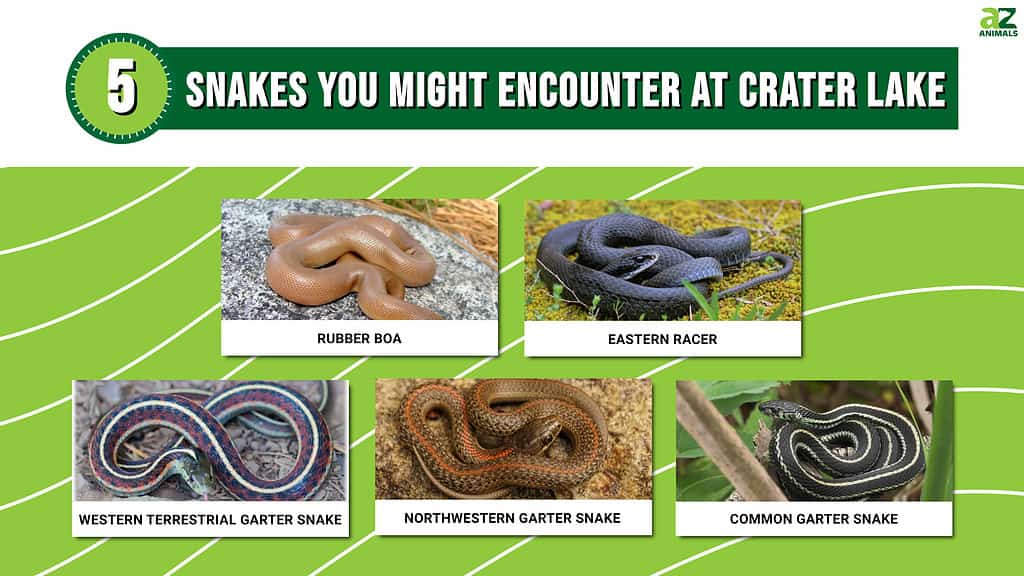
About Crater Lake

If you want a great wildlife viewing area, consider Crater Lake in Oregon.
©Wollertz/Shutterstock.com
Crater Lake, located in southern Oregon, is a breathtaking natural wonder that has been the site of Crater Lake National Park since 1902. The lake is the deepest in the United States and the seventh deepest in the world, with a depth of 1,949 feet. It was formed over 7,700 years ago after the collapse of Mount Mazama and is filled with pristine blue water, the result of more than 150 inches of snow each year.
The park is home to many breathtaking geological features, including the Wizard Island cinder cone, the Phantom Ship rock formation, and breathtaking cliffs that plunge into the depths of the lake. Visitors to the park can explore the lake’s rim by hiking, camping, and picnicking. There are also boat tours that provide a unique perspective of the lake, as well as a lake cruise in the summer months.
The park is home to a variety of wildlife, including deer, elk, bears, and many species of birds. Visitors may also spot eagles, ospreys, and other raptors soaring above the lake. There are also a few types of non-venomous snakes at Crater Lake.
Crater Lake is a natural wonder that is not to be missed. Its beauty, serenity, and wildlife make it a unique and unforgettable experience. The park provides a stunning backdrop for spending time with family and friends and a chance to experience the beauty of nature.
5 Snakes at Crater Lake
No need to be alarmed. No poisonous snakes inhabit Crater Lake. Oregon is home to two kinds of Western rattlesnakes, which are the only venomous snakes in the state. The Northern Pacific subspecies can be found in the southwestern part of Oregon, the middle and southern Willamette Valley, and the Columbia Plateau. The Great Basin subspecies is located in south-central and southeastern Oregon.
1. Rubber Boa

The skin of this snake has a wrinkly and soft appearance.
©Matt Jeppson/Shutterstock.com
Rubber Boa (Charina bottae) is a species of snake found in the western United States and Canada. It is one of two species in the genus Charina, the other being the Arboreal Rubber Boa (Charina Arborea).
The rubber boa gets its name from its skin, which is soft and wrinkled and covered in small, shiny scales. It can be tan to dark brown, olive green, orange, or even yellow. Newly born snakes are usually pink and slightly translucent, but this changes as they age. These snakes have small eyes with upright ellipse-shaped pupils and short heads that are the same width as their bodies. Additionally, they have short, unpointed tails that look just like their heads. Because of these features, these snakes are usually easy to spot among other species that inhabit the same area.
The rubber boa is a slow-moving snake that feeds on small mammals, lizards, amphibians, and occasionally small birds. It is a secretive species and is usually found hiding under rocks or logs. It is a nonvenomous species and is not considered a threat to humans.
The rubber boa is a popular pet due to its docile nature and small size. It is an ideal pet for those who want a snake that is easy to handle and requires minimal care. They are also popular among reptile enthusiasts who appreciate their unique appearance and behavior.
2. Eastern Racer
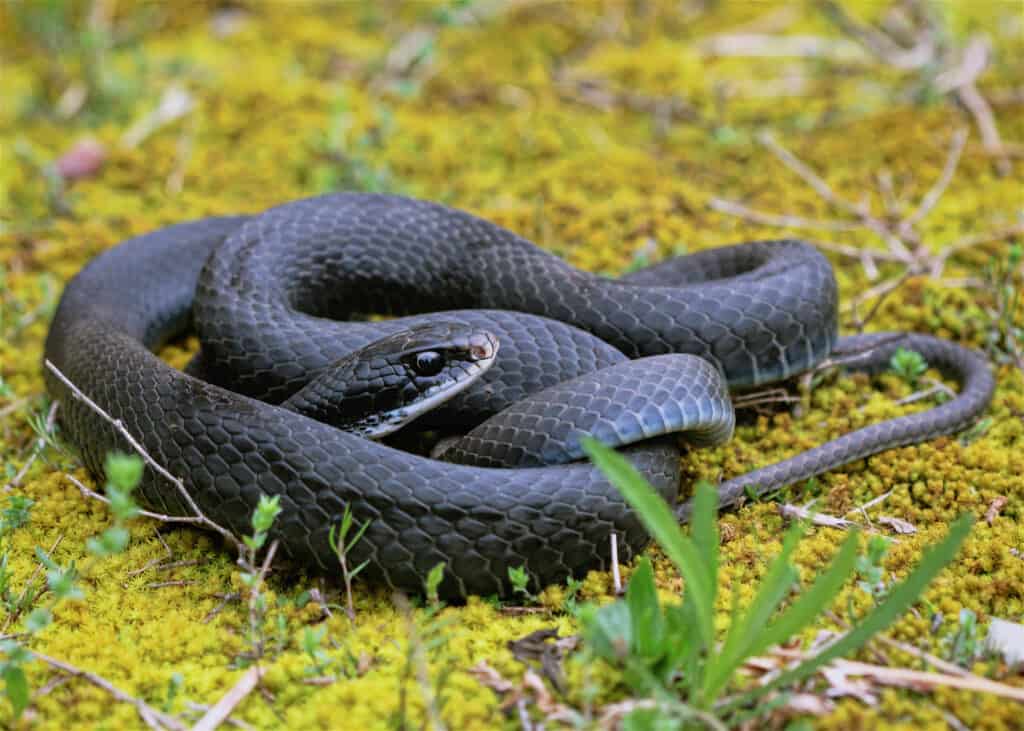
Racers eat small animals like rodents, frogs, toads, lizards, birds, and bird eggs.
©Matthew L Niemiller/Shutterstock.com
Eastern Racer, also known as Coluber constrictor, is a species of nonvenomous snake found throughout much of North America. It is one of the longest species of snake in the region, reaching lengths of over six feet. The average length is between two to five feet, which includes the tail.
Eastern racers are usually slender and smooth-scaled, with a grey to brownish-green coloration. Their underbelly is lighter in color, usually tan, yellow, or white. They are fast-moving and can be seen basking in the sun on roadsides, lawns, and other open areas. They are diurnal, meaning they are active during the day, and they feed on small animals such as frogs, lizards, and mice.
Eastern Racers are a beneficial species for humans, as they help keep populations of small animals under control. They are also valuable to the environment by helping to keep food chains in balance.
Despite their large size, Eastern Racers are nonvenomous and not considered a threat to humans. In fact, they often flee from people and can be quite skittish. If startled, they will usually coil up and hiss but will rarely bite.
3. Western Terrestrial Garter Snake
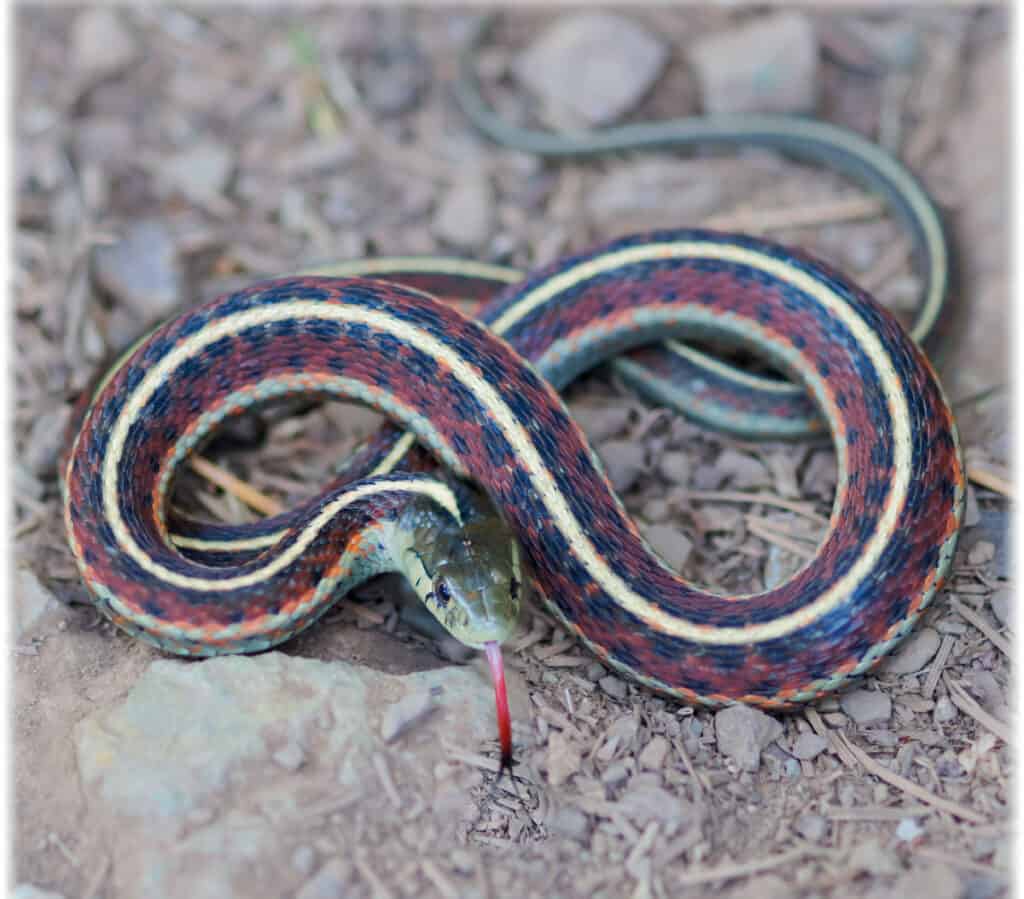
The Western terrestrial garter snake, or coastal garter, is one of the snakes at Crater Lake.
©iStock.com/yhelfman
The Western terrestrial garter snake (Thamnophis elegans) is a species of aquatic and terrestrial garter snake native to western North America. It is one of the most widespread garter snake species, found from southern British Columbia south through most of California and east to western Montana. It prefers wet areas and is a common snake to see around Crater Lake.
The snake is medium-sized, typically ranging from 20-40 inches in length. It is mostly gray or brown in color, with two yellow or white stripes running along its body. Its head is usually black, and it has a yellow or white collar around its neck. The belly is generally yellow or white, sometimes with black spots.
The western terrestrial garter snake can display a wide range of colors on its back and sides, including yellow, light orange, white, red, and black. Even though it is a fairly common species, accurately identifying it can be difficult due to its variety of patterns.
These snakes feed mainly on amphibians, fish, and small mammals. They are mostly active during the day and hibernate during the colder winter months. They are a non-venomous species and pose no threat to humans.
4. Northwestern Garter Snake
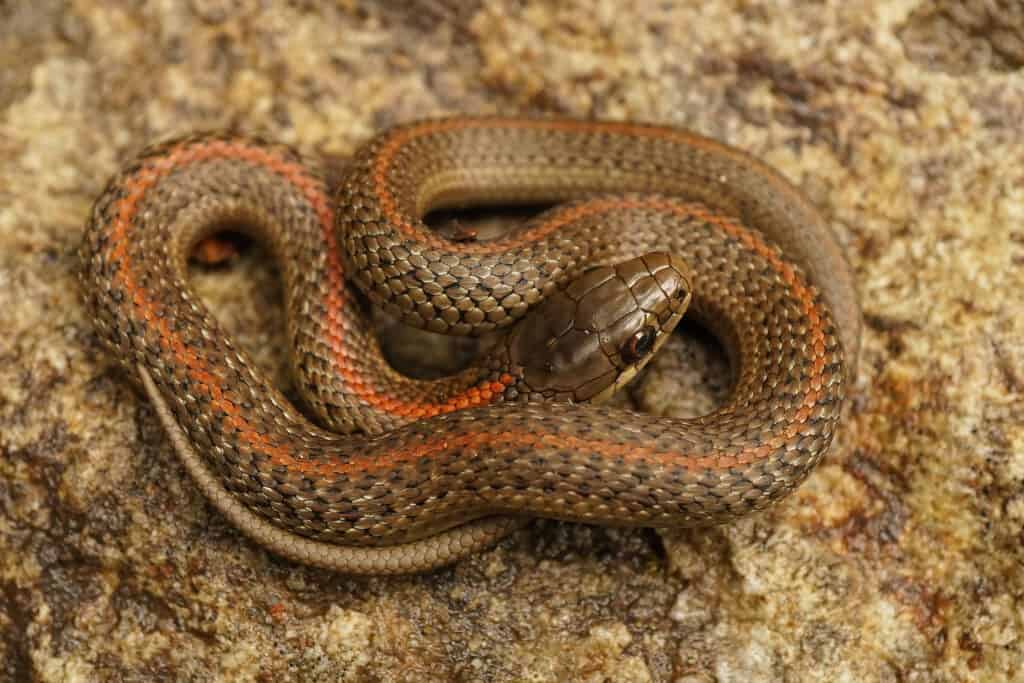
There are many colors of Northwestern Gartersnake,
Thamnophis ordinoides.©HWall/Shutterstock.com
The Northwestern garter snake (Thamnophis ordinoides) is a species of snake that lives in the Pacific Northwest of North America. It is a medium-sized snake, typically growing to between 16 and 23 inches in length. Its body is typically brownish-green, with a yellow or white stripe running along its back. Although there are many variations of color, including a dorsal color of gray, black, brown, or dark brown. Their stripes can be orange, red, turquoise, blue, white, or yellow. These variations make them more difficult to identify.
This species lives in a variety of habitats, including grassland, shrubland, wetlands, and woodlands. It is a semi-aquatic species and is most commonly happy in the riparian areas of its range. It is a diurnal species, meaning it is active during the day.
These snakes are often seen basking in the sun during the day, as well as foraging for food. They feed on a variety of prey items, including insects, amphibians, and small fish. They are viviparous, meaning they give birth to live young.
Due to the Northwestern garter snake’s wide range and adaptability, it is not currently considered to be threatened. It is a beneficial species, as it controls insect populations, which can be damaging to crops. Despite this, they still face threats from habitat destruction, pollution, and predation.
5. Common Garter Snake

The most common color of a garter snake
(Thamnophis sirtalis)is dark brown with yellow stripes.
©iStock.com/rkhalil
The common garter snake (Thamnophis sirtalis) is a species of snake found across North America. They are usually between 18-26 inches in length and have a distinctive pattern of stripes on their back. They can grow to 54 inches in length if they live long enough. Their coloration is usually yellow, green, or brown, and they have black stripes and spots. The most common color variation is brown with yellow stripes, but many deviations exist.
Common garter snakes make their home in a variety of habitats, ranging from woodlands and fields to wetlands and near lakes and streams. They feed primarily on small fish, frogs, salamanders, and earthworms. They are diurnal creatures, meaning they are most active during the day.
Common garter snakes are non-venomous and usually shy away from humans when encountered. When threatened, they may coil up and strike, but they are not aggressive and rarely bite. They can also secrete a foul-smelling musk, which can be used to ward off predators.
Common garter snakes are an important species for many ecosystems as they help keep populations of their prey in check. They are also an important food source for other predators, such as birds of prey.
What to Do If You Encounter a Snake at Crater Lake
If you encounter a non-venomous snake at Crater Lake, there are a few things you should do. First, remain calm and do not panic. Snakes are a natural part of the environment and are usually more scared of you than you are of them. Secondly, keep your distance and give the snake space to move away. Finally, admire the snake from a distance and appreciate its beauty!
You can also take a picture or write down a description of the snake and report it to the National Park Service. They love to hear from visitors and keep an active log of which animals people spot.
Other Wildlife at Crater Lake
Oregon is home to a rich abundance of wild animals, and Crater Lake National Park is a prime wildlife viewing area. Here are only a handful of the wonderful animals you can see if you visit.
Elk
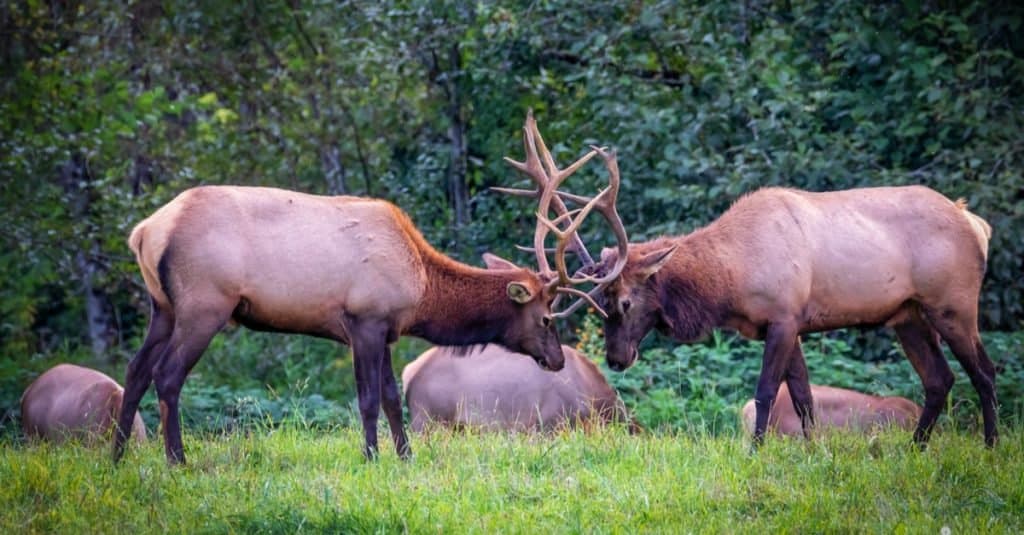
The Roosevelt elk was named for President Theodore Roosevelt.
©Mark A Lee/Shutterstock.com
Oregon is home to Roosevelt Elk. These majestic animals are found throughout the state’s forests and mountains. Elk are large ungulates, with males weighing up to 1000 pounds and standing nearly 6 feet tall. They are an iconic symbol of the Pacific Northwest and a joy to watch. Elk are also an important part of the ecosystem, providing food for other animals and helping to shape the landscape. The Oregon Department of Fish and Wildlife works to protect elk habitats and populations throughout the state.
Mule Deer

There are several types of deer in Oregon.
©iStock.com/twildlife
A mule deer is a medium-sized ungulate mammal found in western North America. They have large, mule-like ears, a white-tailed body, and a black-tipped tail. They can weigh up to 330 pounds and stand up to four feet tall at the shoulder. Mule deer have reddish-brown coats with lighter-colored underbellies and white patches on their throat, rump, and inner legs. Their antlers, which can reach up to three feet in length, have three points on each side. Mule deer are fast and agile and capable of running up to 40 miles per hour over short distances. They are herbivores, feeding on grasses, herbs, shrubs, and some vines. They are mostly active during the day but can be seen foraging at night as well. Mule deer are typically found in open woodlands and shrublands but can also be seen in mountainous regions.
White-Tailed Deer

Deer usually give birth to their babies at Crater Lake during the months of May and June.
©Jim Cumming/Shutterstock.com
White-tailed deer are graceful animals with reddish-brown fur, a white underside, and a white tail with a black tip. They have large ears and a long muzzle, and their antlers can grow up to four feet wide. They are found in forests, meadows, and prairies and are both solitary and social creatures. White-tailed deer are herbivores, eating mostly plants, grasses, and shrubs. They are agile and swift, able to run up to 35 miles per hour and jump up to 8 feet in a single bound. They are also excellent swimmers. White-tailed deer are a common sight in North America and can live up to 15 years in the wild.
Coyote
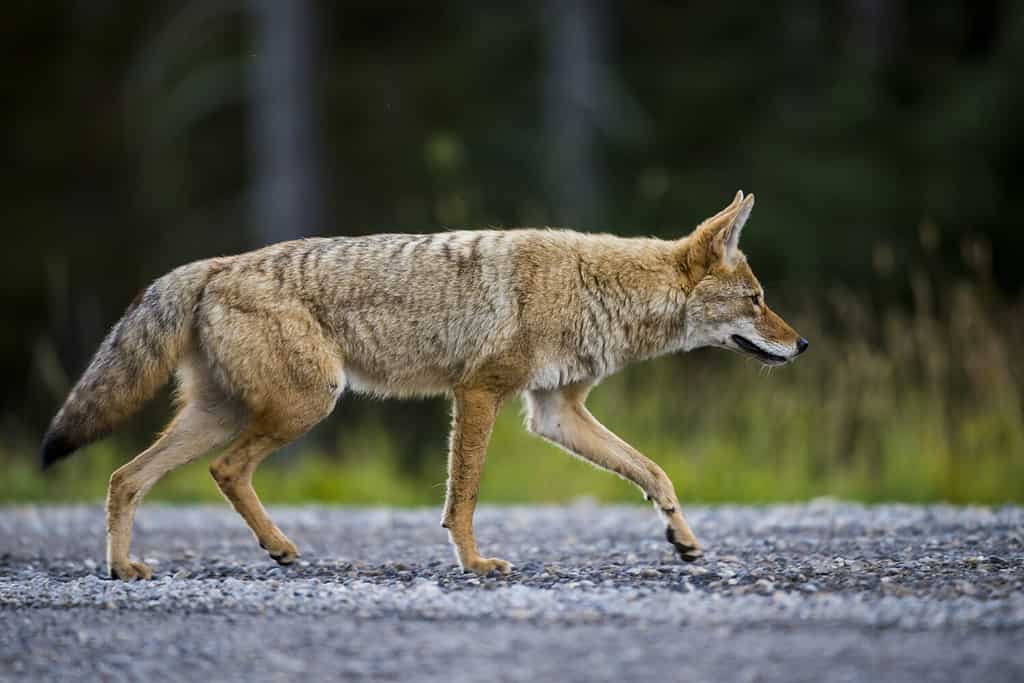
coyotes are mid-size dogs.
©BGSmith/Shutterstock.com
A coyote is a wild canine found throughout North and Central America. It is a medium-sized animal with a slender build and a bushy tail. A coyote’s fur is typically a mix of brown, gray, and black, and its face has a characteristic black mask across its eyes. Its ears are large and pointed, and its legs are long and powerful. Its howl is a distinctive sound that can be heard in the night. Coyotes are highly adaptable, living in a variety of habitats, from deserts to forests. They are mainly scavengers but also hunt small mammals, birds, and reptiles. Coyotes are also known to form strong family bonds and will often live in packs.
Gray Wolf
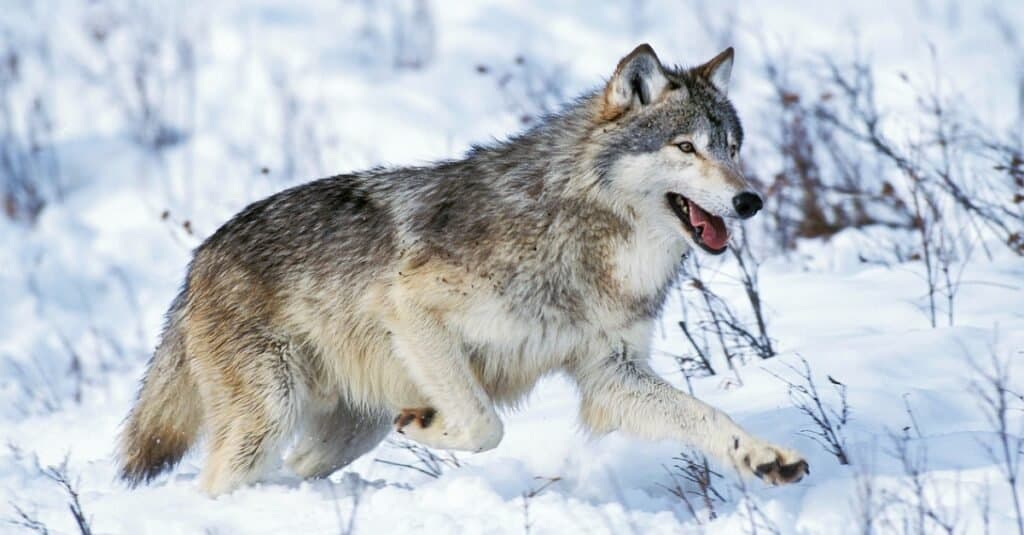
Gray wolves are considered to be elegant predators and highly social animals that form tight, nuclear packs.
©iStock.com/slowmotiongli
A gray wolf is a canine predator that is native to many parts of the Northern Hemisphere. It is the largest species of its family and is characterized by its long coat, pointy ears, and large, bushy tail. It is a powerful animal and is often the apex predator in its environment, hunting and scavenging for food. The gray wolf has a social hierarchy and lives in groups of closely related members known as packs. They communicate with each other through various vocalizations and physical gestures. Gray wolves primarily eat large animals such as deer, elk, and caribou but will also feed on small mammals and sometimes even scavenge for food. They are essential to preserving healthy ecosystems and have been subject to human persecution for many years.
Gray and Red Fox

Both red and gray foxes live at Crater Lake, Oregon.
©Ondrej Prosicky/Shutterstock.com
Gray foxes have gray fur with a black-tipped tail, while red foxes have thick reddish-brown fur with a white-tipped tail. Gray foxes are typically smaller than red foxes and have a more varied diet, while red foxes are larger and mainly eat small rodents. Both species have pointed ears and are found living in forests, grasslands, and other habitats. Both species are solitary, nocturnal hunters that use various sounds and movements to communicate. Gray foxes have the ability to climb trees, while red foxes are more adapted to running and leaping. Both species face possible threats from habitat loss, human-related activities, and disease.
Bobcat

You can live near a
bobcat
and never see one. They are very sneaky cats.
©Chris Desborough/Shutterstock.com
A bobcat is a medium-sized wildcat native to North America. It has a short, reddish-brown coat, a black-tipped tail, and distinctive black bars on its forelegs. Bobcats are solitary animals, usually living alone or in pairs, and they typically hunt small mammals like rabbits and hares. They are also excellent climbers and swimmers. Bobcats are highly adaptable, living in a variety of habitats, including woodlands, deserts, and even near urban areas. They are nocturnal and highly secretive, so they are rarely seen in the wild. Bobcats are a valuable part of the ecosystem, helping to keep small animal populations in balance.
Mountain Lion
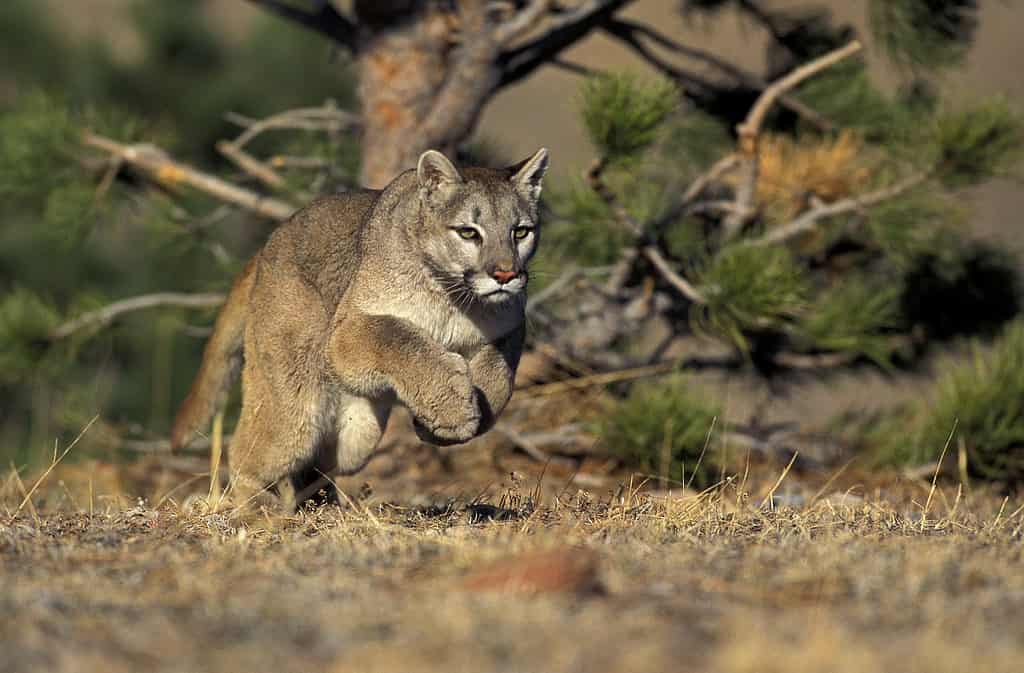
If you hear a noise like a woman screaming in the woods, it could be a mountain
lion
.
©iStock.com/slowmotiongli
Mountain lion, also known as cougar, puma, or panther, is a large, solitary wild cat found in the western United States. It has a tawny-brown coat and a long tail. Its claws are strong and sharp, its head is rounded, and its ears are small and tufted. It is a powerful and efficient predator, primarily hunting deer, elk, squirrels, and ground birds. Mountain lions are stealthy and swift, able to cover large distances quickly. They are solitary, nocturnal, and shy animals and are rarely seen by humans. They are highly adaptable to different habitats and can live in a variety of areas, including forests, deserts, and grasslands. Mountain lions are an iconic species of the American West that play a significant role in the region’s ecosystems. The snakes at Crater Lake have to watch out for cougars. They eat snakes!
Western Spotted Skunk
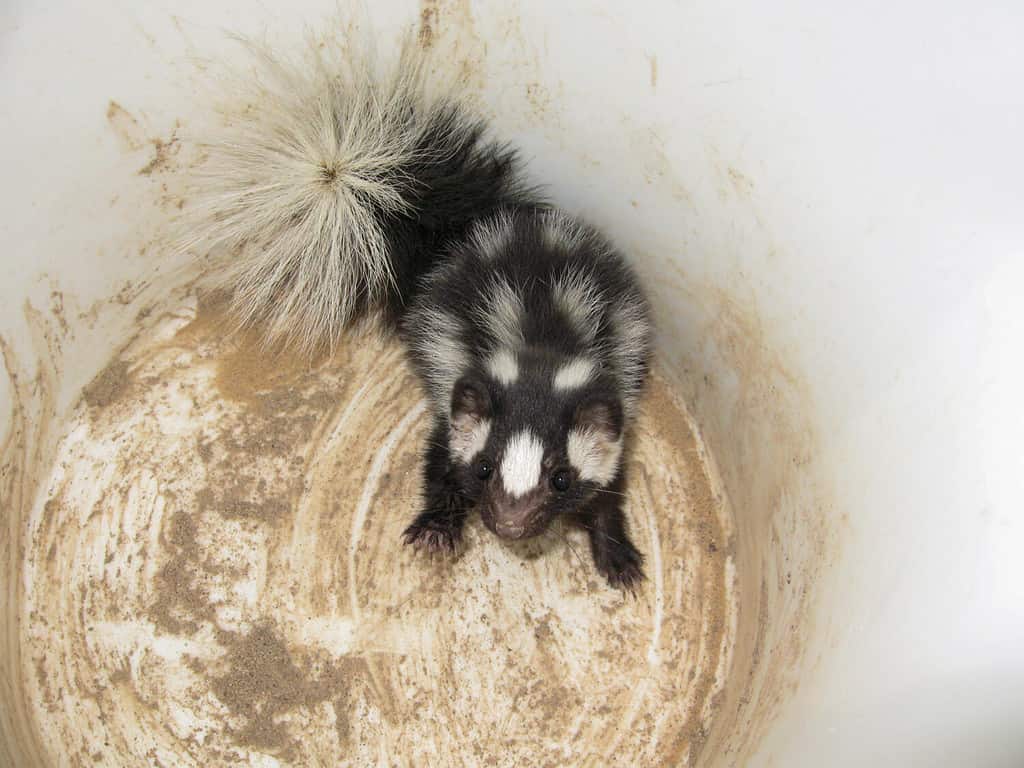
Skunks eat many different types of foods, including fruit and veggies.
©rawaccess/Shutterstock.com
A western spotted skunk is a small, black and white mammal native to western North America. It has a distinctive white stripe on its back and two white spots on its head and back. It has a long, bushy tail with several white bands. The western spotted skunk is a carnivore, eating insects, small rodents, and other small animals. It also eats fruit and vegetation. The western spotted skunk is nocturnal, spending its days in burrows, rock crevices, and tree hollows. During the night, it forages for food. It is also known to spray a strong-smelling liquid as a defense mechanism against predators. The western spotted skunk is an important part of the food chain, providing food for larger predators such as foxes and coyotes.
The photo featured at the top of this post is © iStock.com/Photographer and videographer from Ukraine
Thank you for reading! Have some feedback for us? Contact the AZ Animals editorial team.






